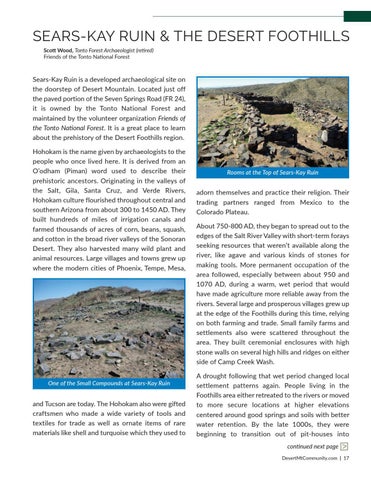SEARS-KAY RUIN & THE DESERT FOOTHILLS Scott Wood, Tonto Forest Archaeologist (retired) Friends of the Tonto National Forest
SearsKay Ruin is a developed archaeological site on the doorstep of Desert Mountain. Located just off the paved portion of the Seven Springs Road (FR 24), it is owned by the Tonto National Forest and maintained by the volunteer organization Friends of the Tonto National Forest. It is a great place to learn about the prehistory of the Desert Foothills region. Hohokam is the name given by archaeologists to the people who once lived here. It is derived from an O’odham (Piman) word used to describe their prehistoric ancestors. Originating in the valleys of the Salt, Gila, Santa Cruz, and Verde Rivers, Hohokam culture flourished throughout central and southern Arizona from about 300 to 1450 AD. They built hundreds of miles of irrigation canals and farmed thousands of acres of corn, beans, squash, and cotton in the broad river valleys of the Sonoran Desert. They also harvested many wild plant and animal resources. Large villages and towns grew up where the modern cities of Phoenix, Tempe, Mesa,
One of the Small Compounds at Sears-Kay Ruin
and Tucson are today. The Hohokam also were gifted craftsmen who made a wide variety of tools and textiles for trade as well as ornate items of rare materials like shell and turquoise which they used to
Rooms at the Top of Sears-Kay Ruin
adorn themselves and practice their religion. Their trading partners ranged from Mexico to the Colorado Plateau. About 750800 AD, they began to spread out to the edges of the Salt River Valley with shortterm forays seeking resources that weren’t available along the river, like agave and various kinds of stones for making tools. More permanent occupation of the area followed, especially between about 950 and 1070 AD, during a warm, wet period that would have made agriculture more reliable away from the rivers. Several large and prosperous villages grew up at the edge of the Foothills during this time, relying on both farming and trade. Small family farms and settlements also were scattered throughout the area. They built ceremonial enclosures with high stone walls on several high hills and ridges on either side of Camp Creek Wash. A drought following that wet period changed local settlement patterns again. People living in the Foothills area either retreated to the rivers or moved to more secure locations at higher elevations centered around good springs and soils with better water retention. By the late 1000s, they were beginning to transition out of pithouses into continued next page
L
DesertMtCommunity.com | 17












